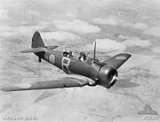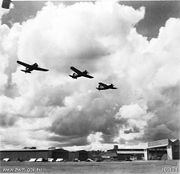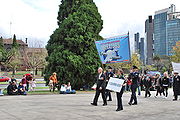
No. 21 Squadron RAAF
Encyclopedia
No. 21 Squadron is a Royal Australian Air Force
general reserve squadron. It saw action as a fighter, dive bomber
and heavy bomber
unit during World War II
.
) squadron. Shortly after the outbreak of World War II, it began operating CAC Wirraway
s.
 In mid-1941, as war with Japan
In mid-1941, as war with Japan
became more likely, the squadron was re-designated a fighter unit and was sent to augment four other British Commonwealth
units in Malaya
, including No. 453 Squadron RAAF
. The only fighter available was the Brewster Buffalo
.
The five British Commonwealth units — including two RAF and one RNZAF squadrons — that flew Buffalos in the Malayan campaign
were beset with numerous problems, including: poorly-built and ill-equipped planes; inadequate supplies of spare parts; inadequate numbers of support staff; airfields that were difficult to defend against air attack; lack of a clear and coherent command structure; antagonism between RAF and RAAF squadrons and personnel, and inexperienced pilots lacking appropriate training. No. 21 Squadron suffered severe losses to Japanese fighters, on the ground and in the air, during the first week of the campaign, resulting in its operational merger with 453 Squadron, and later with other Buffalo squadrons. Surviving pilots were evacuated to the Dutch East Indies
No. 21 Squadron suffered severe losses to Japanese fighters, on the ground and in the air, during the first week of the campaign, resulting in its operational merger with 453 Squadron, and later with other Buffalo squadrons. Surviving pilots were evacuated to the Dutch East Indies
and from there to Australia. The squadron was disbanded in Fremantle
in March 1942.
Following further attacks in March against enemy camps around Pommern Bay and Rempi village, it was decided the short flying range of the Vengeance was unsuitable for the New Guinea campaign and No. 21 Squadron returned to Australia on 13 March 1943. Moving to Camden, the squadron converted to B-24 Liberator
heavy bombers in June 1943. The unit did not see operational service again until January 1945, when it attacked targets at Laga and a radio station at Moena Island. During January and February more than a hundred missions were flown against Japanese targets. In April the squadron attacked a convoy of ships near Koepang, damaging a cruiser. Other targets attacked included troop areas at Tawo and fuel tanks in Tarakan and Borneo. The squadron's operations in the last months of the war were concentrated around supporting the allied landings at Labuan and Balikpapan
http://www.awm.gov.au/units/unit_11055.asp. Following the end of the war the unit's aircraft were used as shipping escorts and as transports before returning to Tocumwal, New South Wales.
 In December 1947, No. 21 Squadron, now located at RAAF Base Amberley
In December 1947, No. 21 Squadron, now located at RAAF Base Amberley
began to replace its Liberators with Avro Lincoln
bombers. An aircraft was lost at Amberley on 19 February 1948, killing all 16 people on board. After being briefly renamed No. 2 Squadron from February to April 1948, the squadron was re-formed as No. 21 (City of Melbourne) Squadron at RAAF Williams
as a Citizen Air Force (reserve) fighter squadron. It flew CAC Wirraway
, P-51 Mustang
and de Havilland Vampire
aircraft from 1948 until 1960. The squadron ceased flying operations in 1960 and became a non-flying general reserve squadron headquartered at RAAF Williams
near Melbourne
. On 1 July 2010, No. 21 (City of Melbourne) Squadron amalgamated with Combat Support Unit Williams to become an integrated Permanent Air Force and Reserve unit responsible for airfield and base support and reserve training.
Royal Australian Air Force
The Royal Australian Air Force is the air force branch of the Australian Defence Force. The RAAF was formed in March 1921. It continues the traditions of the Australian Flying Corps , which was formed on 22 October 1912. The RAAF has taken part in many of the 20th century's major conflicts...
general reserve squadron. It saw action as a fighter, dive bomber
Dive bomber
A dive bomber is a bomber aircraft that dives directly at its targets in order to provide greater accuracy for the bomb it drops. Diving towards the target reduces the distance the bomb has to fall, which is the primary factor in determining the accuracy of the drop...
and heavy bomber
Heavy bomber
A heavy bomber is a bomber aircraft of the largest size and load carrying capacity, and usually the longest range.In New START, the term "heavy bomber" is used for two types of bombers:*one with a range greater than 8,000 kilometers...
unit during World War II
World War II
World War II, or the Second World War , was a global conflict lasting from 1939 to 1945, involving most of the world's nations—including all of the great powers—eventually forming two opposing military alliances: the Allies and the Axis...
.
History
No. 21 Squadron was formed at RAAF Base Laverton in April 1936, as a Citizen Air Force (reserveMilitary reserve
A military reserve, tactical reserve, or strategic reserve is a group of military personnel or units which are initially not committed to a battle by their commander so that they are available to address unforeseen situations or exploit suddenly developing...
) squadron. Shortly after the outbreak of World War II, it began operating CAC Wirraway
CAC Wirraway
The Wirraway was a training and general purpose military aircraft manufactured in Australia by the Commonwealth Aircraft Corporation between 1939 and 1946...
s.
Fighter unit in Malaya

Empire of Japan
The Empire of Japan is the name of the state of Japan that existed from the Meiji Restoration on 3 January 1868 to the enactment of the post-World War II Constitution of...
became more likely, the squadron was re-designated a fighter unit and was sent to augment four other British Commonwealth
Commonwealth of Nations
The Commonwealth of Nations, normally referred to as the Commonwealth and formerly known as the British Commonwealth, is an intergovernmental organisation of fifty-four independent member states...
units in Malaya
British Malaya
British Malaya loosely described a set of states on the Malay Peninsula and the Island of Singapore that were brought under British control between the 18th and the 20th centuries...
, including No. 453 Squadron RAAF
No. 453 Squadron RAAF
No. 453 Squadron is a Royal Australian Air Force air traffic control unit. It was first was formed at Bankstown in New South Wales on 23 May 1941 during World War II and was disbanded in March 1942 after suffering heavy losses in combat during the Battle of Malaya...
. The only fighter available was the Brewster Buffalo
Brewster Buffalo
The Brewster F2A Buffalo was an American fighter aircraft which saw limited service early in World War II. Though the Buffalo won a competition against the Grumman F4F Wildcat in 1939 to become the US Navy's first monoplane fighter aircraft, it turned out to be a big disappointment...
.
The five British Commonwealth units — including two RAF and one RNZAF squadrons — that flew Buffalos in the Malayan campaign
Battle of Malaya
The Malayan Campaign was a campaign fought by Allied and Japanese forces in Malaya, from 8 December 1941 – 31 January 1942 during the Second World War. The campaign was dominated by land battles between British Commonwealth army units, and the Imperial Japanese Army...
were beset with numerous problems, including: poorly-built and ill-equipped planes; inadequate supplies of spare parts; inadequate numbers of support staff; airfields that were difficult to defend against air attack; lack of a clear and coherent command structure; antagonism between RAF and RAAF squadrons and personnel, and inexperienced pilots lacking appropriate training.

Dutch East Indies
The Dutch East Indies was a Dutch colony that became modern Indonesia following World War II. It was formed from the nationalised colonies of the Dutch East India Company, which came under the administration of the Netherlands government in 1800....
and from there to Australia. The squadron was disbanded in Fremantle
Fremantle, Western Australia
Fremantle is a city in Western Australia, located at the mouth of the Swan River. Fremantle Harbour serves as the port of Perth, the state capital. Fremantle was the first area settled by the Swan River colonists in 1829...
in March 1942.
Bomber squadron in Australia
In September 1943 No. 21 Squadron was re-formed at Gawler, South Australia and re-equipped with Vultee Vengeance dive bombers. In December the unit moved to Lowood in Queensland for advanced training. In January and February 1944 the squadron then moved to Nazdab in New Guinea. By the end of February the unit had commenced attacks on Japanese barge hide-outs on the Wagol River, and was part of combined raids with other squadrons on the airstrips at Hansea Bay, Madang and Alexishafen.Following further attacks in March against enemy camps around Pommern Bay and Rempi village, it was decided the short flying range of the Vengeance was unsuitable for the New Guinea campaign and No. 21 Squadron returned to Australia on 13 March 1943. Moving to Camden, the squadron converted to B-24 Liberator
B-24 Liberator
The Consolidated B-24 Liberator was an American heavy bomber, designed by Consolidated Aircraft of San Diego, California. It was known within the company as the Model 32, and a small number of early models were sold under the name LB-30, for Land Bomber...
heavy bombers in June 1943. The unit did not see operational service again until January 1945, when it attacked targets at Laga and a radio station at Moena Island. During January and February more than a hundred missions were flown against Japanese targets. In April the squadron attacked a convoy of ships near Koepang, damaging a cruiser. Other targets attacked included troop areas at Tawo and fuel tanks in Tarakan and Borneo. The squadron's operations in the last months of the war were concentrated around supporting the allied landings at Labuan and Balikpapan
Battle of Balikpapan (1945)
The Battle of Balikpapan was the concluding stage of the Borneo campaign . The landings took place on 1 July 1945. The Australian 7th Division, composed of the 18th, 21st and 25th Infantry Brigades, with support troops, made an amphibious landing, codenamed Operation Oboe Two a few miles north of...
http://www.awm.gov.au/units/unit_11055.asp. Following the end of the war the unit's aircraft were used as shipping escorts and as transports before returning to Tocumwal, New South Wales.
Post-war

RAAF Base Amberley
RAAF Base Amberley is a Royal Australian Air Force base located southwest of Ipswich, Queensland and southwest of Brisbane. It is currently home to No. 1 Squadron and No. 6 Squadron , No. 33 Squadron and No. 36 Squadron...
began to replace its Liberators with Avro Lincoln
Avro Lincoln
The Avro Type 694, better known as the Avro Lincoln, was a British four-engined heavy bomber, which first flew on 9 June 1944. Developed from the Avro Lancaster, the first Lincoln variants were known initially as the Lancaster IV and V, but were renamed Lincoln I and II...
bombers. An aircraft was lost at Amberley on 19 February 1948, killing all 16 people on board. After being briefly renamed No. 2 Squadron from February to April 1948, the squadron was re-formed as No. 21 (City of Melbourne) Squadron at RAAF Williams
RAAF Williams
RAAF Williams comprises the two bases of Point Cook and Laverton. Both establishments previously existed as separate RAAF Bases until 1999 when they were amalgamated to form RAAF Williams...
as a Citizen Air Force (reserve) fighter squadron. It flew CAC Wirraway
CAC Wirraway
The Wirraway was a training and general purpose military aircraft manufactured in Australia by the Commonwealth Aircraft Corporation between 1939 and 1946...
, P-51 Mustang
P-51 Mustang
The North American Aviation P-51 Mustang was an American long-range, single-seat fighter and fighter-bomber used during World War II, the Korean War and in several other conflicts...
and de Havilland Vampire
De Havilland Vampire
The de Havilland DH.100 Vampire was a British jet-engine fighter commissioned by the Royal Air Force during the Second World War. Following the Gloster Meteor, it was the second jet fighter to enter service with the RAF. Although it arrived too late to see combat during the war, the Vampire served...
aircraft from 1948 until 1960. The squadron ceased flying operations in 1960 and became a non-flying general reserve squadron headquartered at RAAF Williams
RAAF Williams
RAAF Williams comprises the two bases of Point Cook and Laverton. Both establishments previously existed as separate RAAF Bases until 1999 when they were amalgamated to form RAAF Williams...
near Melbourne
Melbourne
Melbourne is the capital and most populous city in the state of Victoria, and the second most populous city in Australia. The Melbourne City Centre is the hub of the greater metropolitan area and the Census statistical division—of which "Melbourne" is the common name. As of June 2009, the greater...
. On 1 July 2010, No. 21 (City of Melbourne) Squadron amalgamated with Combat Support Unit Williams to become an integrated Permanent Air Force and Reserve unit responsible for airfield and base support and reserve training.

